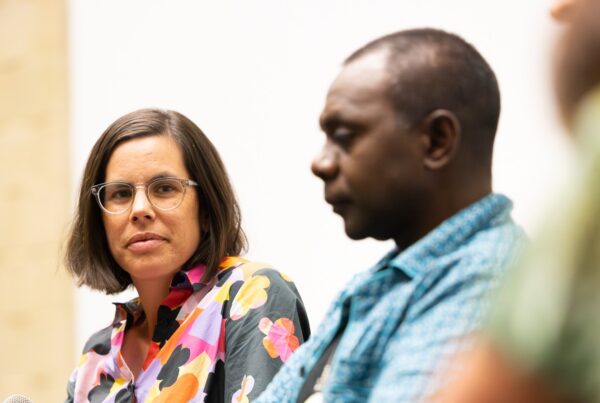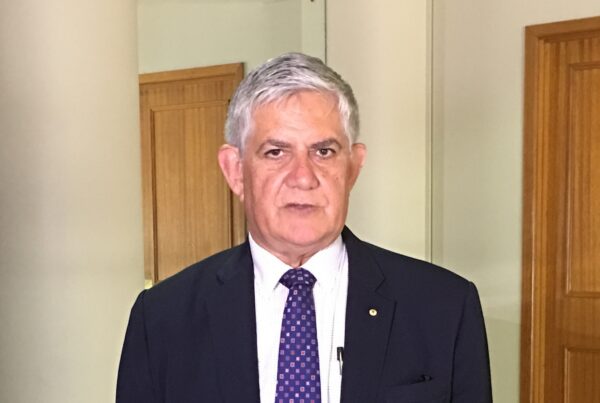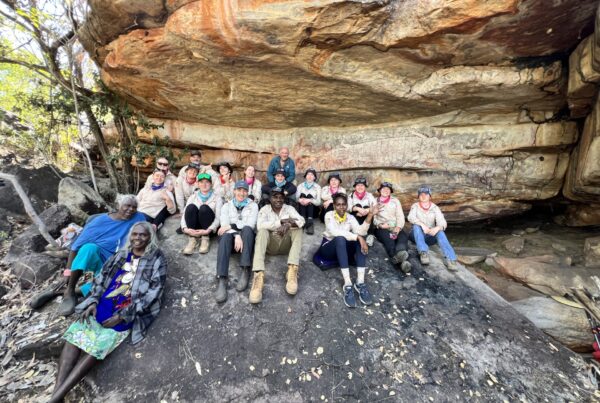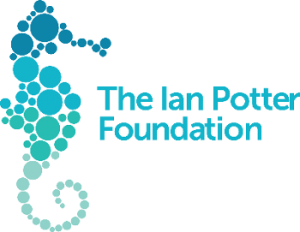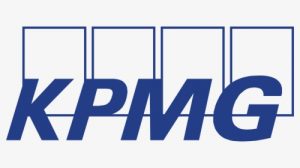Sebastian Nagrrugrruba Galbirrbirr (Njanjma Rangers) at the Old Man’s Hand site, Red Lily, west Arnhem. Photo: Tristen Jones
New Indigenous Leadership, Collaborative Research in
Arnhem Land, and Advancing Rock Art Research Across Australia
It is the end of the year, and Rock Art Australia is entering a new chapter. The appointment of our first Indigenous Chair, the announcement of a new 5-year collaborative research partnership in Arnhem Land, and the establishment of a new Chair in Rock Art and Archaeology at Griffith University are significant developments that strengthen national research and leadership in Australian rock art and archaeological science.
Amid these exciting milestones, we also take a moment to acknowledge a great loss.
The appointment of Hon Ken Wyatt AM as Chair of Rock Art Australia brings Indigenous leadership and cultural knowledge to the forefront of Rock Art Australia’s mission and reflects RAA’s commitment to ensuring that Aboriginal voices guide the future of rock art research and preservation.
The establishment of a new Professorial Chair in Rock Art and Archaeology at Griffith University with Professor Chris Clarkson as the inaugural Chair is an important development. The RAA-funded Chair will lead research spanning rock art, archaeology, Indigenous knowledge, digital innovation, and human origins in one of RAA’s priority regions – Arnhem Land.
It is RAA’s third Chair to be established at an Australian university and firmly sets up Rock Art Australia as the most significant funder nationally of leading-edge research into Australia’s earliest history.
We are delighted to announce the appointment of Dr Sam Harper as the inaugural Rock Art Australia Research Fellow at the University of Western Australia. Sam has previously worked on RAA-funded research including Kimberley Visions. This role enables RAA to continue our tradition of funding and advancing rock art research in the Kimberley.
Many of you know Dr Helen Green for her critical work over many years on the Rock Art Dating project. Helen is now leading RAA’s national research program as our inaugural Director of Research.
Together, these initiatives expand Rock Art Australia’s partnerships and reinforce our commitment to innovative research. With your support we are strengthening Australia’s national research capability.
To fully realise the potential of the new Chair, and ensure its long-term impact, we invite you to support us in shaping one of the most significant advancements in Australian archaeology and Indigenous heritage research.
It’s the festive season and there is much to celebrate at Rock Art Australia!
🎄

Cas Bennetto. CEO
Ken Wyatt Leads Rock Art Australia

Hon Ken Wyatt AM. Photo: Ingo Burkhardt
“Our rock art tells the story of our people, our ancestors, and our country. These are like manuscripts on stone”, says Ken Wyatt
“It is so important to research and protect it. It is a privilege to help guide Rock Art Australia’s work so that we understand through scientific research and Aboriginal knowledge the history of human habitation in Australia and that Indigenous voices remain central in research for generations to come”. Ken Wyatt
Dr Helen Green leads Rock Art Australia’s National Research and Indigenous Engagement Program
Helen’s new role oversees the development and management of research activities for Rock Art Australia. She will set research priorities, monitor existing RAA-funded projects, and help the collaboration between researchers, executive leadership, funding bodies, and community and industry partners. Her work ensures that RAA-funded research aligns with our research goals.
Helen is also the Chair of RAA’s Science Advisory Council who hold their annual workshop in Perth at the end of this month. The workshop program Culture, Community & Connection will bring together researchers and Indigenous partners, as well as students and board members.
NEW Rock Art Australia Professorial Chair in Rock Art and Archaeology
Professor Chris Clarkson, a Fellow of the Australian Academy of the Humanities, is the newly appointed Professorial Chair in Rock Art and Archaeology at Griffith University.
Chris, an internationally recognised archaeologist at the Australian Research Centre for Human Evolution (ARCHE) at Griffith University, is renowned for his landmark excavation at Madjedbebe rock shelter in Arnhem Land, in partnership with the Mirarr Traditional Owners and the Gundjeihmi Aboriginal Corporation. His findings uncovered evidence of human occupation in northern Australia dating back 65,000 years.
Rock Art Australia has supported Chris’s research previously including inviting him to develop a national research ‘blueprint’ to guide RAA’s rock art strategy.
This new RAA-funded Chair will lead research spanning rock art, archaeology, Indigenous knowledge, digital innovation, and human origins. This work sits squarely within Rock Art Australia’s goals.
Linking ancient rock art stories to the scientific record of sea-level rise: NEW Five-Year Research Project in Western Arnhem Land
The Australian Research Council (ARC) has announced funding for Human Responses to Post-Glacial Sea Level Rise at Red Lily, Arnhem Land, a major new five-year linkage project. The multidisciplinary research will be led by Prof Clarkson with 18 Chief Investigators, and Rock Art Australia as Partner Investigator represented by Dr Helen Green.
Rock Art Australia congratulates all researchers and partners involved in the successful submission, supported by RAA and the ARC, with backing from the Northern Land Council. The team will collaborate with Manilakarr Traditional Owners and Njanjma Rangers.
“The most exciting parts will be working on Country together and linking the ancient rock art stories to the scientific record of sea-level rise, showing how creativity and resilience have always gone hand in hand in this remarkable landscape”, said Prof Clarkson.
This project investigates human-environment responses to the Last Glacial Maximum and post-glacial sea-level rise at Red Lily Lagoon, Arnhem Land, generating new insights into climate change impacts, strengthening Traditional Owner heritage management, training students, and informing future adaptation for this nationally significant region.
“We expect this work to reveal how people thrived through massive environmental change, adapting their technology, art, and lifeways as the seas rose and the land transformed beneath their feet”. Prof Chris Clarkson.
Research Fellow Advancing Kimberley Studies
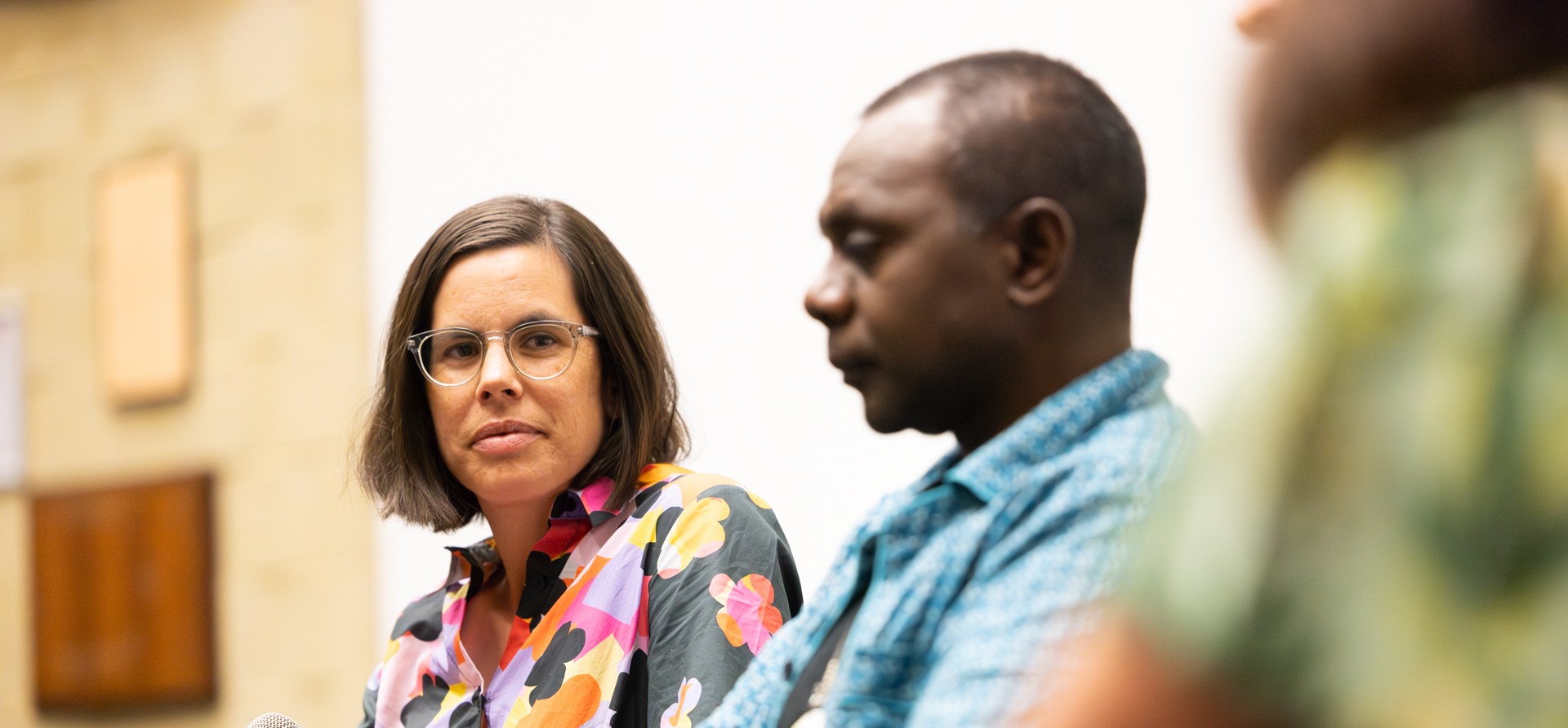
Sam Harper (left), pictured with Ian Waina (right). Photo by Manny Tamayo
Dr Sam Harper, an archaeologist and rock art specialist, is the new Rock Art Australia Research Fellow at the University of Western Australia.
Sam has more than 15 years’ experience in archaeology and heritage management and is based at the Centre for Rock Art Research + Management at UWA. The Fellowship has been established through RAA’s partnership with The University of Western Australia to advance research and training in Kimberley rock art.
Sam will lead interdisciplinary research in the Kimberley exploring how rock art reflects environmental change, cultural continuity, and biodiversity through time. Her current work in the Cockburn Ranges (Balanggarra Country) focuses on style, identity, narrative and engravings, an often-overlooked form of expression in comparison with painted rock art.
In conversation with Rock Art Australia, Sam shares her vision for the Rock Art Australia Kimberley Research Fellowship.
RAA Fellowship Extended for Dr Louise Shewan
Dr Louise Shewan, RAA Research Fellow at the University of Melbourne, continues her work in archaeological science with an extended fellowship through to 2030. Her research strengthens the integration of scientific methods and cultural heritage, providing critical insights into Australia’s human past.
From the Rock Art Australia Minderoo Chair in Archaeological Science, Prof Rachael Popelka-Filcoff
Supporting the Next Generation of Scientists

Pictured from left to right: Dr Maddison Lauer, Louis Cox, Faris Ruzain, Marina Mitsopoulos
RAA is committed to nurturing emerging scientific talent through research training and experience in the field.
“I extend my heartfelt congratulations to all our students on their outstanding achievements. Their curiosity, dedication, and innovative approaches are advancing the frontiers of archaeological science and contributing meaningfully to the understanding and preservation of Australia’s rock art, and its greater context. These accomplishments embody the spirit of collaboration and excellence that Rock Art Australia seeks to foster in the next generation of researchers“. Rachel Popelka-Filcoff
Dr Maddison Lauer recently completed her PhD at the Archaeological Science Laboratory, University of Melbourne. Her research developed innovative methods to characterise and provenance ochre pigments, providing insights into past exchange networks. Using magnetic measurements and isotopic analyses, Maddison’s work reveals the movement and use of pigments in rock art and contributes to the ARC Discovery Project Ochre Archaeomicrobiology: A New Tool for Understanding Aboriginal Exchange.
Louis Cox, a Master’s student at the University of Melbourne, investigated biomineralisation processes in Kimberley rock shelters, which form oxalate-rich mineral accretions essential for radiocarbon dating. His research uncovered evidence of microbially driven formation mechanisms, enhancing understanding of how environmental and microbial processes create datable mineral coatings. Louis was recently awarded the C.M. Tattam Postgraduate Scholarship in recognition of his research achievements.
Marina Mitsopoulos, another RAA-supported researcher, examined how fire affects Kimberley rock art pigments, investigating physical, colourimetric, and mineralogical changes. Her findings provide valuable guidance for preserving ancient artworks in fire-prone environments. Marina also participated in RAA’s School Outreach Program with the Balanggarra Young Ranger group and will present her research at the RAA Science Advisory Council Workshop in Perth this month. She too received the C.M. Tattam Postgraduate Scholarship for her work.
Apply for Rock Art Research Funding
At Rock Art Australia, we bring scientific research and Aboriginal cultural knowledge together to study rock art provinces of Australia. We study them to understand the history of Aboriginal Australia and its significance in the global narrative of human origins and to ensure its protection.
We initiate and support integrated, multi-disciplinary scientific research which is co-developed with Aboriginal communities to ensure it meets the needs for the Aboriginal people of the region. We actively foster engagement with Country and culture.
To learn more about Rock Art Australia’s research priorities and how to apply for RAA research funding, please visit our website by clicking the link below.
For general enquiries please contact: grants@rockartaustralia.org.au
Events
Kingston Library Expert Series Talk

Helen Green presenting at the Kingston Library. Photo: Kingston Library
We were delighted to be part of Victoria’s Kingston Library Expert Series, where Dr Helen Green, RAA’s Director of Research and Chair of the Science Advisory Council, delivered a presentation to the audience.
Helen shared insights into the latest scientific techniques used to determine the age of Australia’s oldest rock art and highlighted innovative projects that bring together traditional Indigenous knowledge and Western science to deepen our understanding and protection of these remarkable cultural records.
We thank Kingston Library for the invitation and their warm hospitality. Rock Art Australia values every opportunity to share our work through public lectures around the country, helping connect communities with the stories and science behind Australia’s extraordinary rock art heritage. Following the success of the event, Helen has been invited back to present again next year.


